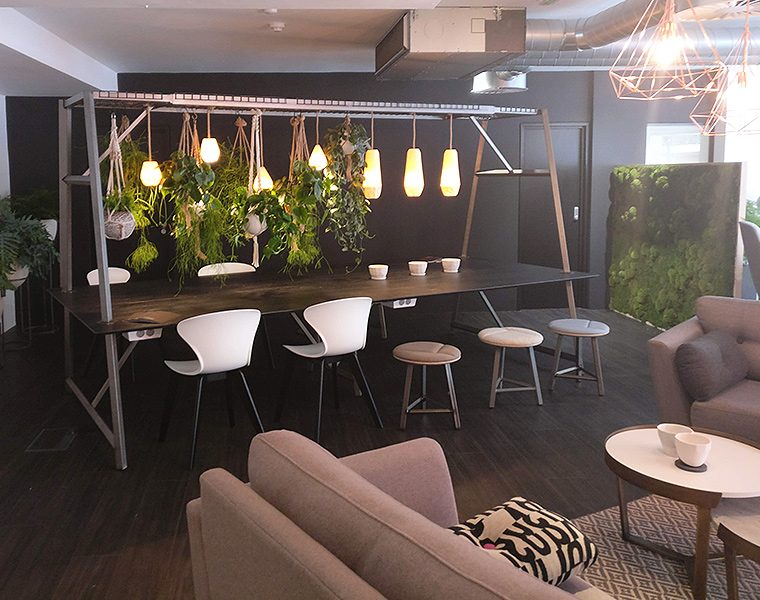Last week Penketh Interiors’s trusty team of workspace designers and workplace consultants swapped our North West headquarters for a trip down South. No, they weren’t off to visit the Queen… they were on their way to another very exciting royal appointment – Clerkenwell Design Week 2018. It’s a hot date in the industry calendar and not one we like to miss (especially when Desso have been tempting us with ice cream from their Nitropod on social media in the run up!)
We may not have got our futuristic ice cream – sad faces all round – but there was plenty to turn our frowns upside down in terms of innovative design and commercial furniture. So much so in fact, we thought we’d share our findings with you in a Clerkenwell Design Week-inspired, 2018 interior design trends report.
So, what exactly are the trends to watch for the rest of the year and heading into 2019?
The “resimercial” design revolution
One of the most prominent trends that the team noticed while they were at the festival was the emergence of resimercial design. Before we tell you a bit more about how you can incorporate this into your own workspace design though, here’s a quick explanation of this prevalent commercial design concept…
What is resimercial design?
The term has been coined by combining the words ‘residential’ and ‘commercial’ and quite literally means incorporating domestic interior décor features into more traditional workspace design schemes. Resimercial design aims to marry the functional requirements of the practical workplace with home comforts to boost morale, motivation, comfort and wellbeing at work.
How does this translate into your workplace design, you might ask…? By simply introducing softer design elements that you might find in residential environments into the workplace. This human-centric approach to commercial interiors calls for things like soft seating, indoor plants, warmer lighting, framed wall décor and a more domestic colour palette.
Biophilic interior design is still big
Yes, you guessed it, biophilia is still influencing commercial interior design in a big way and we’re loving it.
Bringing the great outdoors in
At this point, you don’t need us to regale all of the benefits of having a biophilic workspace. It’s a hot topic. You already know that human nature responds positively when there are natural elements in close proximity and you’re well aware of the physical and mental perks of office plants. Basically, this mantra is still prevalent which is why plants are now doing way more than just sitting in a pot in the welcome space waiting area. They don’t just look pretty – they provide proven health and productivity benefits and we are seeing plant life now being incorporated into hanging features, live walls and functional furniture features. But it’s not just indoor plants and botanical accents that are serving a nod to nature…
Raw and refined office design
On their return from Clerkenwell, the Penketh Interiors team also came back to HQ with reports of a trend towards more organic materials on worktops and surfaces. Our friends at Frovi have described it as ‘raw and refined’ and well, we couldn’t have said it better ourselves. Stealing elements of nature doesn’t have to be as obvious as popping a succulent or a cactus plant on every window ledge.
Materials are being stripped back to nature’s basics but being incorporated into office interior solutions in a way that elevates them to modern sophistication. We noticed a distinct nod to a more industrial aesthetics that industry intel tells us is going to be clinging to the top of the commercial style stakes well into next year.
Popular materials for 2018 and 2019
Wandering around the Clerkenwell exhibition spaces and showrooms, concrete was most definitely a reoccurring motif. On worktops, flooring and even wall coverings, concrete is looking to be king. Also feeding into trends towards raw, organic materials and a more industrial style of workspace design is bare stonework, marble, natural timber finishes, charred wood and raw metals.
A nice set of legs
Black metal furniture legs and exposed framework
Speaking of raw metal materials, black metal furniture legs seem to be casting a shadow over classic wooden legs as commercial furniture design also takes a turn for the more industrial. Tubular metal legs and exposed framework are one of the biggest trends for the foreseeable future and contrast beautifully against the flurry of soft materials like velvet and brushed suede which are taking the forefront in fabric.
Our interior designers advise that if you’re after a luxurious, opulent feel for something like the hospitality or entertainment industry, brass, rose gold or copper are the ideal choice. If you’re doing your workplace design research and looking for interior inspiration more suited to corporate settings or workspaces, black metal frames are the way forward. They’re stylish and modern but subtle enough to weather the evolution of commercial style.
Integrated but understated power points
Our team of designers and workplace specialists have a knack for sniffing out something that is going to be popular and we’re not just talking custard donuts in the kitchen here. While this feature might go virtually undetected to those who don’t know any better, our experts were super impressed with the developments in integrated power being showcased at Clerkenwell Design Week. Power sockets are now being integrated into modern furniture design more subtly than ever before, making plugging in and powering up significantly more seamless and convenient for users.
So, there you have it, our commercial interior design trends for 2018 and 2019! Watch this space to see if concrete is crowned king, if metal framework totally eclipses wooden legs and if we ever do get to try that futuristic ice cream from the Desso Nitropod…
